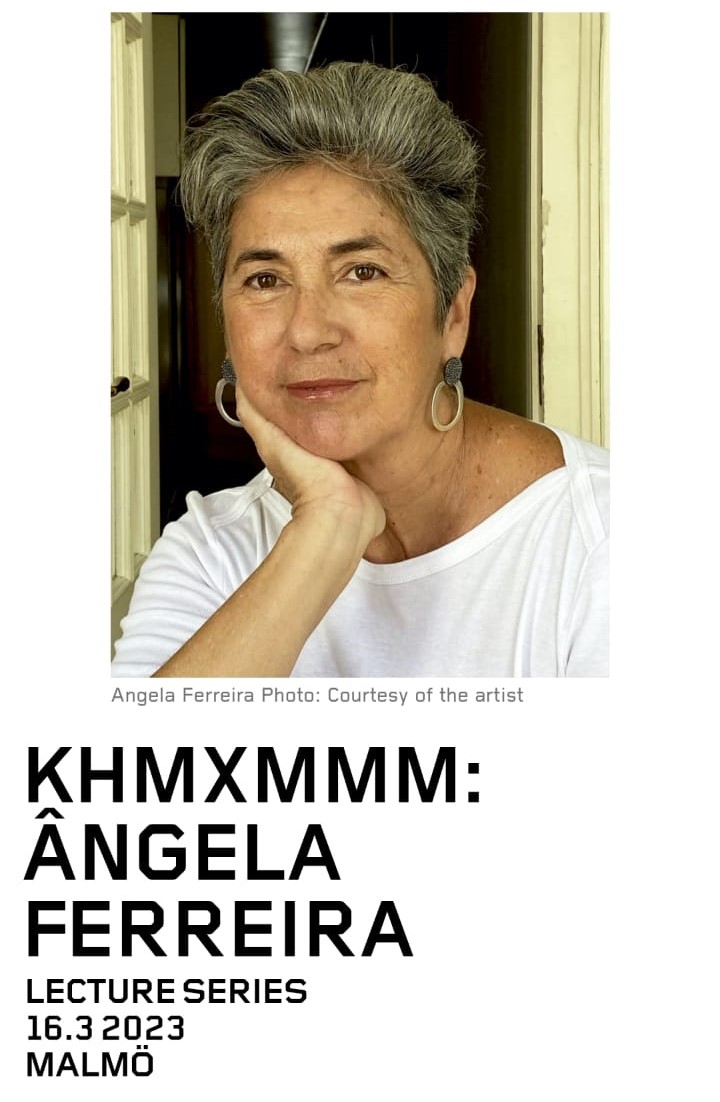
Ângela Ferreira: “The State of Things”
Ângela Ferreira: conferencia “The State of Things” en Moderna Museet Malmo.
Para más información, haga click aquí

Ângela Ferreira: conferencia “The State of Things” en Moderna Museet Malmo.
Para más información, haga click aquí
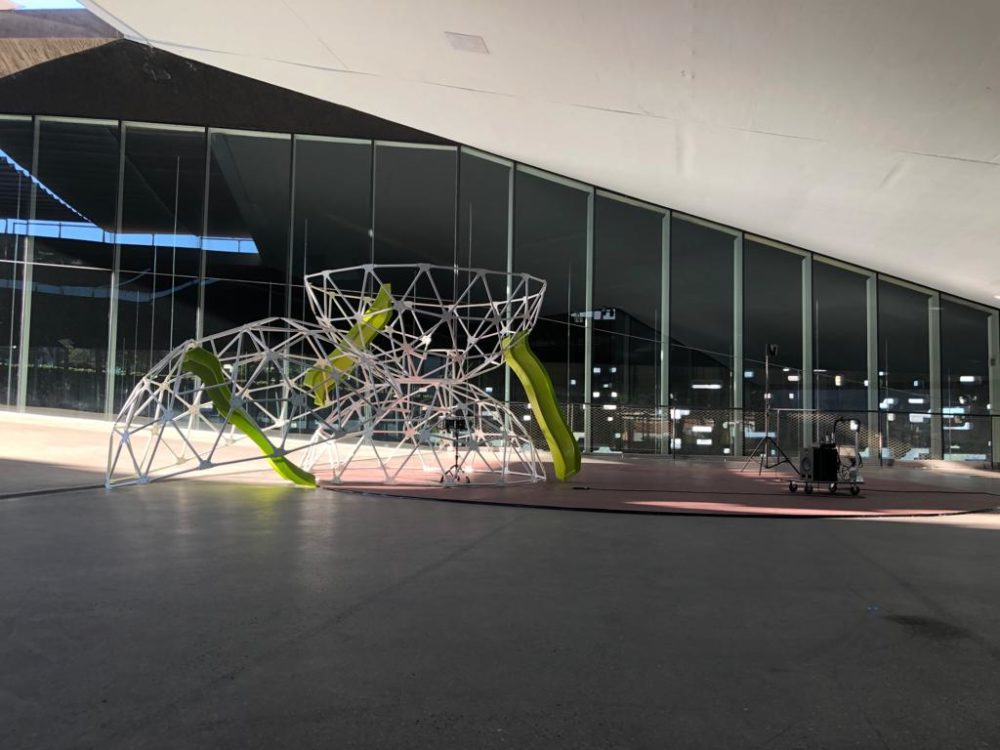
Pipo Hernández Rivero e Israel Galván en Este puede ser el lugar. Tea Tenerife.
Para más información, haga click aquí.
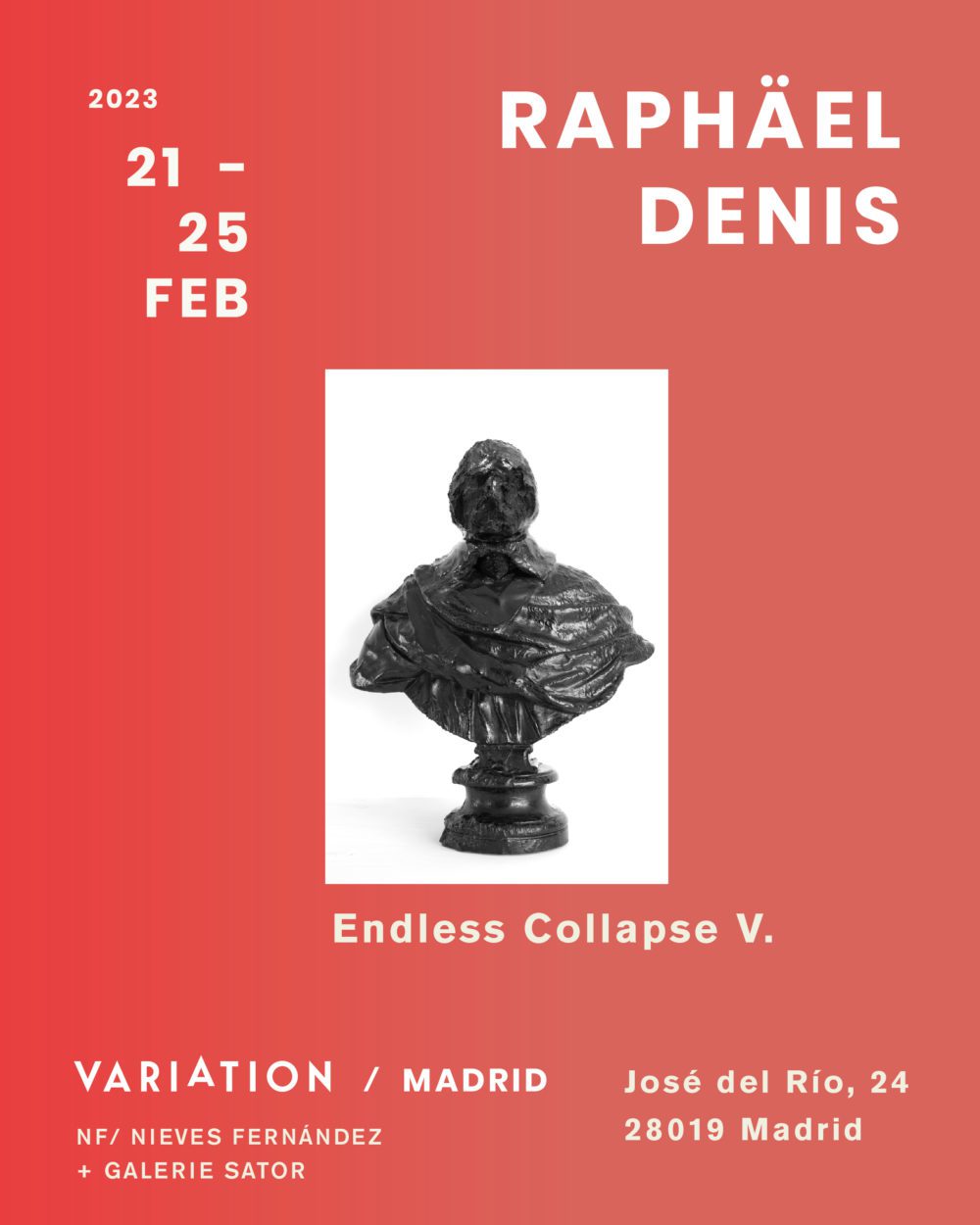
ENDLESS COLLAPSE V, Raphaël Denis.
VARIATION/ Madrid
Raphaël Denis (Paris, 1979) graduado en la Escuela Nacional superior de Artes Decorativas de Paris, vive entre Paris y Bruselas. Su obra forma parte de las colecciones de instituciones como el Centro Pompidou, el Museo de Arte e Historia del Judaísmo en Paris, el FRAC de Alsacia, el Museo de arte e historia de Ginebra o el Kunsthaus de Zurich; así como de colecciones privadas como la colección Frédéric de Goldschmidt de Bruselas, colección Francès y Laurent Dumas – Emerige en Paris o colección Reiner Speck en Düsseldorf.
Artista e investigador, Raphaël Denis plantea cuestiones históricas vinculadas al estatus de la obra de arte. Conocido por su trabajo acerca de la desposesión de la propiedad judía durante la guerra, su obra conmemora la historia del arte y analiza los mecanismos de destrucción y aniquilación a los que los objetos culturales, como expresiones de la identidad humana, pueden ser sometidos. Plásticamente, esta reflexión emerge de su exploración de materiales ampliamente utilizados en la construcción social y urbana como madera, cemento y plomo con diversos amalgamantes negros.
Las piezas presentadas en NAVE N condensan los elementos principales de “La Loi normale des Erreurs”, serie que el artista desarrolla desde 2015.
Expuesta en el Museo Picasso y en el Museo de Arte Moderno de Paris, en el Museo Berggruen Museum en Berlin, y el Kunsthaus de Zurich, “La Loi normale des erreurs” se centra en piezas de arte saqueadas a coleccionistas judíos durante la Segunda Guerra Mundial, piezas destruidas, y piezas de marchantes judíos y franceses como Paul Rosenberg apropiadas por la administración nazi.
VARIATION es un proyecto de la Galerie Sator y NF/NIEVES FERNANDEZ que pretende ampliar la visibilización internacional de los artistas de ambas galerías, a traves de la presentación de proyectos expositivos individuales en Paris y Madrid.
Tras Noli me Tangere, de Clara Sánchez Sala (Octubre 2022, Paris) ENDLESS COLLAPSE V de Raphaël Denis es la segunda edición de VARIATION y tendra lugar en Madrid, en NAVE N, el segundo espacio de la galería NF/NIEVES FERNANDEZ desde el martes 21 hasta el sábado 25 de febrero de 2023.
NAVE N Jose del Rio, 24. Madrid Martes 21 February de 16 a 20h Jueves 23 Feb. previa cita Viernes 24 Feb. de 10 am (champagne breakfast) a 20h. Sabado 25 Feb. de 10 a 18h.
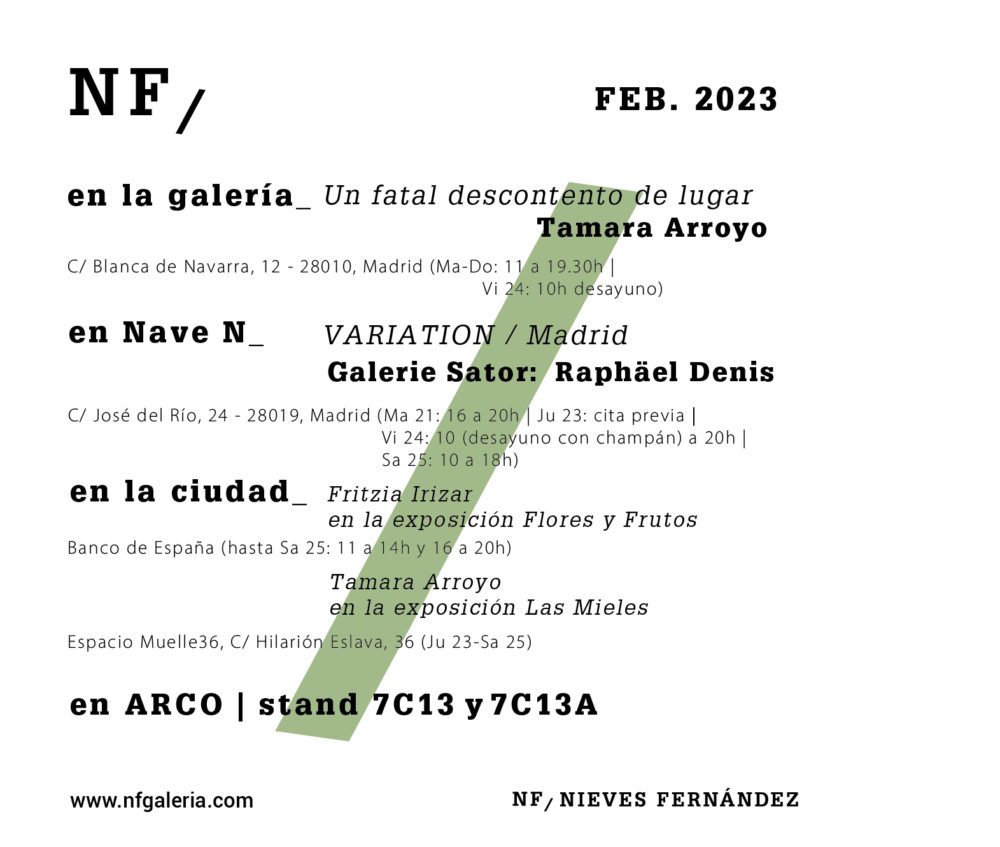
Durante la semana de la feria, también exponemos en la galería Un fatal descontento de lugar, de Tamara Arroyo, y en Nave N con Galerie Sator la obra de Raphäel Denis, en la segunda edición de VARIATION.
Las artistas Fritzia Irizar y Tamara Arroyo, a su vez, participan en las exposiciones de Banco de España y de Espacio Muelle36, abiertas al público hasta el sábado 25 de febrero.
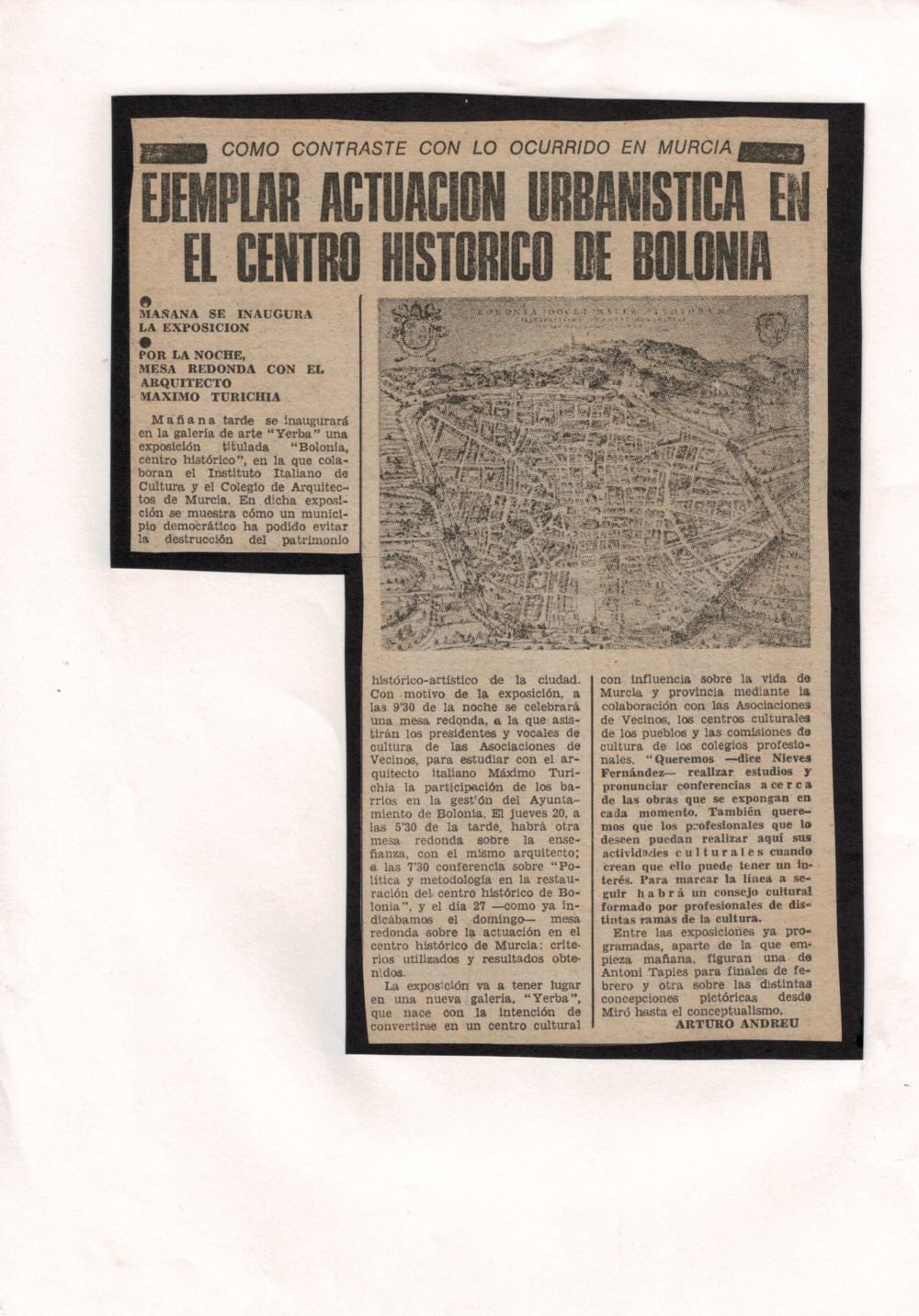
Queridos amigos y amigas,
¡Hoy NF/NIEVES FERNÁNDEZ cumple 46 años!
Al celebrarlo y mirar atrás, nos ha saltado a la vista que continuamos fieles a la misión con la que Nieves Fernández inauguró Yerba en el año 1977: la de situar el arte y el pensamiento en el centro de nuestras acciones, la de comprender la poesía como un mecanismo de revuelta necesario.
Yerba nació en Murcia con la intención de, además de galería y librería, realizar estudios y dar conferencias acerca de las obras expuestas en cada momento. Deseaba que los profesionales encontrasen en él un lugar para desarrollar diversas actividades culturales que tuvieran interés y que su trayectoria se apoyase en distintas ramas de la cultura.
En 2023 honramos este camino y somos coherentes con él. Trabajamos con artistas fundamentales en nuestros primeros pasos, y con otros igualmente importantes para definirnos y desafiarnos. Su diversidad de trayectoria, lenguaje y procedencia nos ayuda a buscar un nuevo espacio de entendimiento, a poner y a estimular la sociedad en la que vivimos. A los artistas, gracias.
La galería es un espacio dinámico, abierto a la crítica y al encuentro entre creadores y público. Además de las exposiciones, organizamos charlas y presentaciones, y también INTERLUDIO, un programa de muestras cortas para que artistas, representados o no, presenten piezas inéditas que necesitan de un formato distinto de apreciación. El último de los Interludios celebrados fue Cuando todo era nada, del Calixto Ramírez, y pronto anunciaremos el siguiente. La galería también promueve CAMPING, proyecto sin ánimo de lucro que ocupa nuestro espacio con danza, música y performance para potenciar redes de manera permeable y participativa. La semana que viene, los días 27 y 28, tendrá lugar la novena edición de CAMPING, con Poliana Lima y Lucas Condró.
A los que nos acompañáis en esta aventura, gracias.
Además, hemos creado VARIATION junto a la parisina Galerie Sator, la cual nos acogió en su espacio de Le Marais en octubre, y expondrá en el nuestro de Carabanchel entre el 22 y el 26 de febrero. Por otro lado, con la mexicana Arroniz, la colombiana Nueveochenta y la alemana Michael Sturm hace tiempo compartimos recursos en la plataforma experimental cooperativa Noplace.
En las próximas semanas inauguraremos en la galería Un fatal descontento de lugar de Tamara Arroyo, y participaremos en ARCO Madrid con nuestro stand y un solo project de Pipo Hernández Rivero. Además, en primavera presentaremos Autoretrato, una película sobre Jordi Teixidor realizada por Miguel Alvarez, Álvaro Oliveros y Bruno Dozza.
Os invitamos a seguirnos en Instagram para estar al día de toda nuestra programación para este año que empieza. ¡Deseamos que esté lleno de arte, proyectos, colaboraciones y revueltas! ¡Gracias por celebrarlo con nosotras!
Dear friends,
Today NF/NIEVES FERNÁNDEZ is 46 years old!
As we celebrate and look back, we remain faithful to the mission with which Nieves Fernandez inaugurated Yerba in 1977: to place art and thought at the center of our actions and to understand poetry as a necessary mechanism of revolt.
Yerba was born in Murcia with the intention of, in addition to being a gallery and bookstore, carrying out studies and giving lectures about the works exhibited there at any given time. It wanted professionals to find in it a place to develop diverse cultural activities and to have a trajectory that would be supported by different branches of culture.
In 2023 we honor this path and are consistent with it. We work with fundamental artists in our first steps, and with others equally important to define and challenge us. Their diversity of background, language, and provenance helps us to seek a new space of understanding, to put and stimulate the society in which we live. To the artists, thank you.
The gallery is a dynamic space, open to criticism and to the encounter between creators and the public. In addition to the exhibitions, we organize talks and presentations, and also INTERLUDIO, a program of short exhibitions for artists, represented or not, to exhibit unpublished pieces that need a different format of appreciation. The last of the Interludios held was ‘When everything was nothing’, by Calixto Ramírez, and we will soon announce the next one. The gallery also promotes CAMPING, a non-profit project that occupies our space with dance, music, and performance to promote networks in a permeable and participatory way. Next week, on the 27th and 28th, the ninth edition of CAMPING will take place, with Poliana Lima and Lucas Condró.
To those of you who join us in this adventure, thank you.
In addition, we have created VARIATION with the Parisian Galerie Sator, which welcomed us in its space in Le Marais in October, and will exhibit in ours in Carabanchel between February 22 and 26. On the other hand, with the Mexican Arroniz, the Colombian Nueveochenta, and the German Michael Sturm, we share resources in the experimental cooperative platform Noplace.
In the coming weeks, we will open at the gallery ‘Un fatal descontento de lugar’ by Tamara Arroyo, and we will participate in ARCO Madrid with our stand and a project by Pipo Hernández Rivero. In addition, in spring we will present ‘Autoretrato’, a film about Jordi Teixidor by Miguel Alvarez, Álvaro Oliveros, and Bruno Dozza.
We invite you to follow us on Instagram to keep up to date with all our programming for this new year, we hope it will be full of art, projects, collaborations, and revolts! Thank you for celebrating with us!
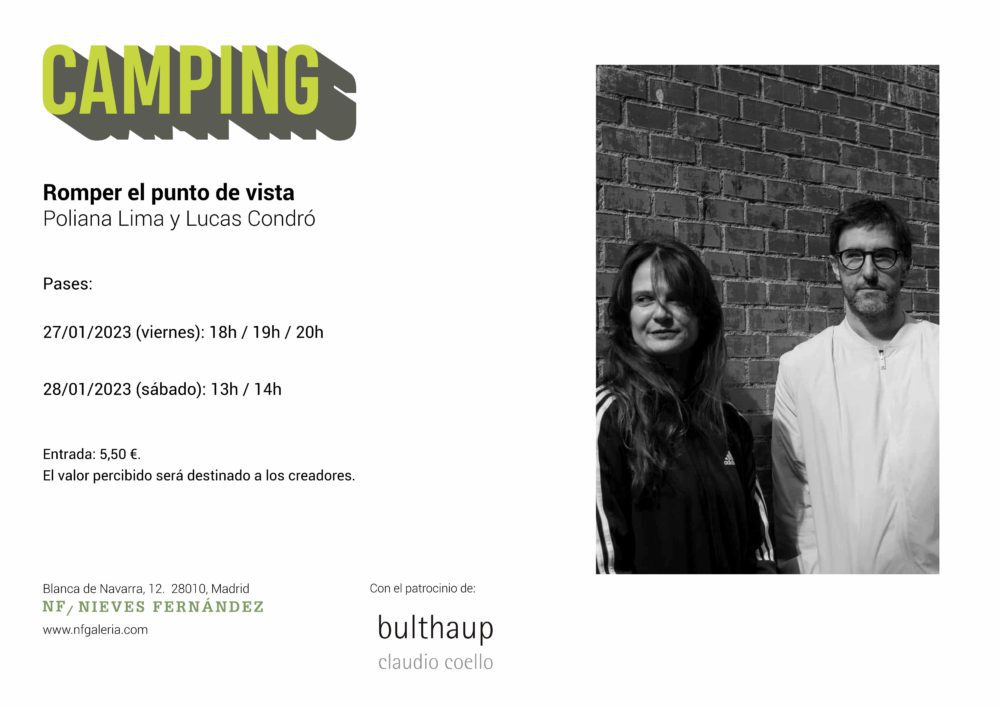
PARA COMPRAR LA ENTRADA, PINCHA AQUÍ.
‘Ningún gesto es espontáneo, cada movimiento del cuerpo está configurado por nuestras experiencias, nuestra historia, los contextos en los que hemos crecido.
Nuestros gestos son una acumulación infinita de nuestras vivencias pasadas.
El cambio surge al relacionar esos gestos con el contexto inmediatamente presente y así generar rupturas que desplieguen nuevos puntos de vista.‘
Poliana Lima- Lucas Condró
_
Poliana Lima (Brasil, 1983) coreógrafa, bailarina y docente, afincada en Madrid.
Licenciada en Ciencias Sociales por la Universidad Estadual de Campinas y formada en ballet clásico y danza contemporánea en São Paulo. En 2011 realiza su primera pieza corta ‘Palo En La Rueda’. En 2012 realiza, con la coreógrafa lituana Ugne Dievaityte, las piezas ‘Es Como Ver Nubes’, galardonada con el premio del Público del XXVI Certamen Coreográfico de Madrid, el segundo premio en el Certamen de Una Pieza y el primer premio en el Festival Vila Real en Danza 2014, y ‘Flesh’, pieza con la que recorren festivales nacionales e internacionales como Fringe Edinbugh, Spring Forward Aerowaves, Mercat de Flors, Dansa València, New Baltic Dance, Madrid en Danza etc. En 2013 participa en el proyecto europeo ‘Performing Gender’ y crea la performance ‘Cuerpo-Trapo’ para el Museo de Arte Contemporáneo de Zagreb, Croacia. En 2014 ‘Atávico’, su primer ensemble, es galardonado con el primer premio en el XXVIII Certamen Coreográfico de Madrid, además del premio del Público, el premio de la Crítica, la Beca Dance Web 2015 (Impulstanz Viena) y la residencia en Tanzhaus, Zurich. En 2017, estrena su solo HUECO en los Teatros del Canal de Madrid y en el Festival BAD Bilbao. Artista Asociada a Conde Duque Madrid entre 2018-2020 desarrolla su proyecto coreográfico-documental ’Aquí, Siempre’ y ’Las cosas en la distancia’. En 2020 estrenó ’Las cosas se mueven, pero no dicen nada’ en los Teatros del Canal, coproducida por el Festival DDD en Oporto, el CND Pantin/París y Porosus Fonds de Dotation. Pieza seleccionada para Aerowaves, ha sido representada en el Museo Nacional Centro de arte Reina Sofia. En 2022 estrena Oro Negro en el teatro de La Abadia en Madrid dentro del Festival de Otoño.
Lucas Condró ( Argentina, 1977) es bailarín, coreógrafo y docente.
Desde el año 2012 y hasta la actualidad lleva adelante su proyecto ASYMMETRICAL-MOTION: un trabajo de investigación con el objetivo desarrollar y sistematizar su experiencia en la práctica pedagógica de la danza contemporánea que ha desarrollado en centros como Tik Tak, Bruselas, Bambú Danza, Madrid, KulturKraft Väst, Francia y Suecia, DOCH university, Le Lido, Cullberg Ballet company y Les 7 Doigts de la Main. En Febrero del 2016 publica junto a Pablo Messiez el libro: “Asymmetrical-Motion/Notas sobre pedagogía y movimiento”. Ha participado en “Springdance dialogues” de Jan Ritsema y “Several Species of Small Furry Animas” de Nicole Butler, y trabajado con coreógrafos como Paz Rojo, David Zambrano, Nora Heltman y Katrina Brown. Asimismo, ha co-coreografiado e interpretado la pieza Cuerpo de Baile, de Pablo Messiez. Ha dirigido “El espacio”, pieza creada en el Centro de Coreografía de Montpellier. Junto a Poliana Lima organiza el ciclo de danza MoverMadrid en la sala Cuarta Pared.
CAMPING es un proyecto de Nerea e Idoia Fernández directoras de NF/NIEVES FERNANDEZ y de Blanca Cortés, abogada especializada en propiedad intelectual.
____
TO BUY A TICKET, CLICK HERE.
‘No gesture is spontaneous, every movement of the body is shaped by our experiences, our history, the contexts in which we have grown up.
Our gestures are an infinite accumulation of our past experiences.
Change arises by relating those gestures to the immediately present context and thus generating ruptures that unfold new points of view.’
Poliana Lima- Lucas Condró
_
Poliana Lima (Brazil, 1983) choreographer, dancer and teacher, based in Madrid.
Graduated in Social Sciences from the State University of Campinas and trained in classical ballet and contemporary dance in São Paulo. In 2011 she made her first short piece ‘Palo En La Rueda’. In 2012 she performs, with the Lithuanian choreographer Ugne Dievaityte, the pieces ‘Es Como Ver Nubes’, awarded with the Audience Award of the XXVI Certamen Coreográfico de Madrid, the second prize in the Certamen de Una Pieza and the first prize in the Festival Vila Real en Danza 2014, and ‘Flesh’, a piece with which she toured national and international festivals such as Fringe Edinbugh, Spring Forward Aerowaves, Mercat de Flors, Dansa València, New Baltic Dance, Madrid en Danza etc. In 2013 she participates in the European project ‘Performing Gender’ and creates the performance ‘Cuerpo-Trapo’ for the Museum of Contemporary Art in Zagreb, Croatia. In 2014 ‘Atavico’, her first ensemble, is awarded with the first prize at the XXVIII Certamen Coreográfico de Madrid, as well as the Audience Award, the Critics Award, the Dance Web Scholarship 2015 (Impulstanz Vienna) and the residency at Tanzhaus, Zurich. In 2017, she premieres her solo HUECO at the Teatros del Canal in Madrid and at the BAD Bilbao Festival. Associated Artist at Conde Duque Madrid between 2018-2020 she develops her choreographic-documentary project ‘Aquí, Siempre’ and ‘Las cosas en la distancia’. In 2020 she premiered ‘Las cosas se mueven, pero no dicen nada’ at Teatros del Canal, co-produced by Festival DDD in Oporto, CND Pantin/Paris and Porosus Fonds de Dotation. Selected piece for Aerowaves, it has been performed at the Museo Nacional Centro de arte Reina Sofia. In 2022 he premieres Oro Negro at the Teatro de La Abadia in Madrid as part of the Autumn Festival.
Lucas Condró (Argentina, 1977) is a dancer, choreographer and teacher.
Since 2012 and until today he has been carrying out his project ASYMMETRICAL-MOTION: a research work with the aim of developing and systematizing his experience in the pedagogical practice of contemporary dance that he has developed in centers such as Tik Tak, Brussels, Bambú Danza, Madrid, KulturKraft Väst, France and Sweden, DOCH university, Le Lido, Cullberg Ballet company and Les 7 Doigts de la Main. In February 2016 he published with Pablo Messiez the book: ‘Asymmetrical-Motion/Notes on pedagogy and movement’. He has participated in Jan Ritsema’s ‘Springdance dialogues’ and Nicole Butler’s ‘Several Species of Small Furry Animas’, and worked with choreographers such as Paz Rojo, David Zambrano, Nora Heltman and Katrina Brown. He has also co-choreographed and performed the piece Cuerpo de Baile, by Pablo Messiez. He has directed ‘El espacio’, a piece created at the Montpellier Choreography Center. Together with Poliana Lima, he organizes the dance cycle MoverMadrid at the Sala Cuarta Pared.
CAMPING is a project by Nerea and Idoia Fernández, directors of NF/NIEVES FERNANDEZ and Blanca Cortés, lawyer specialized in intellectual property.
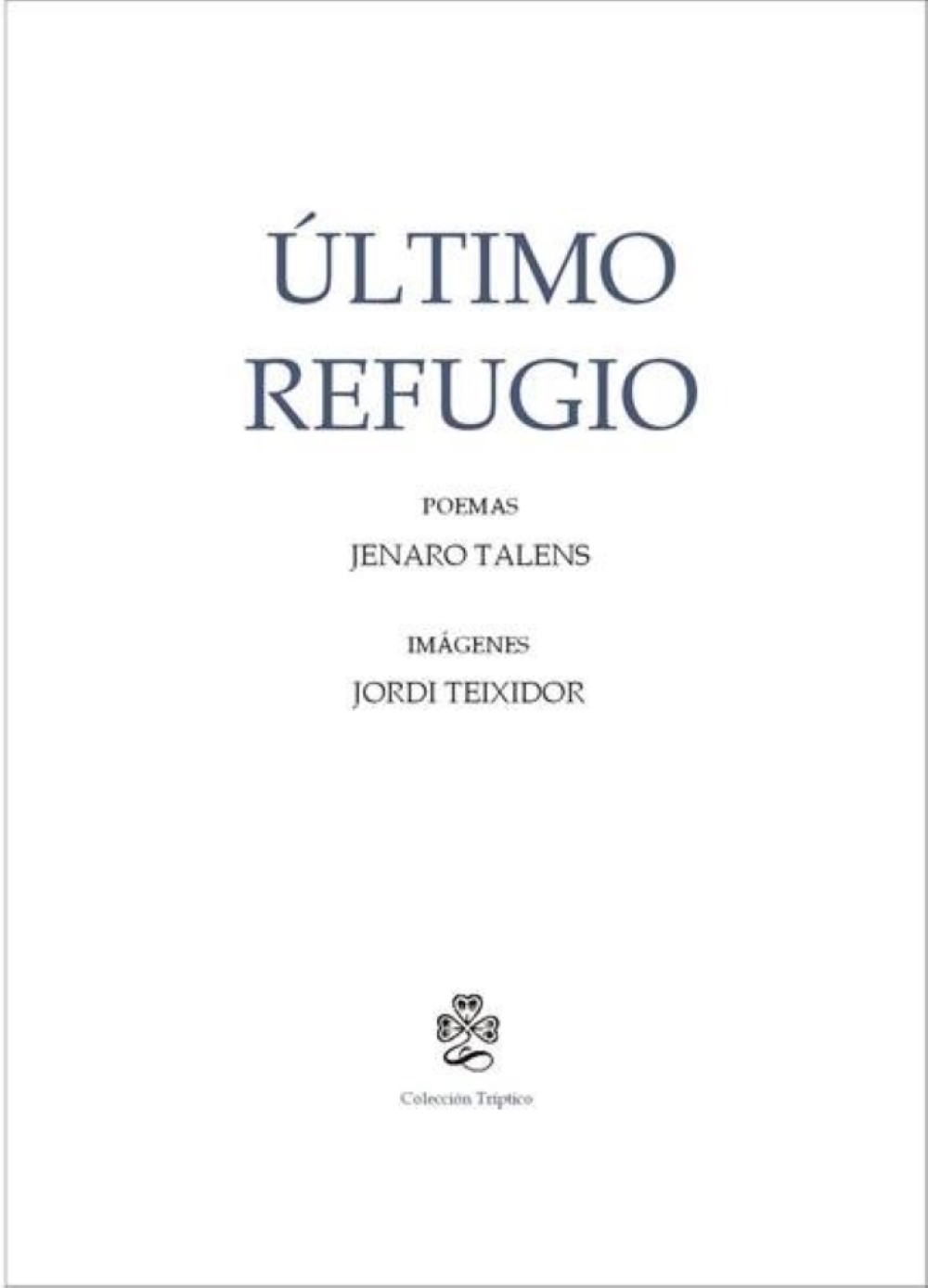
Presentación de ‘Último Refugio: Jenaro Talens y Jordi Teixidor’, Colección Tríptico.
Jueves 19 de enero, 20h. Calle Galileo 52. Madrid
Presentation of ‘Último Refugio: Jenaro Talens and Jordi Teixidor’, Colección Tríptico.
Thursday, January 19, 20h. Calle Galileo 52. Madrid
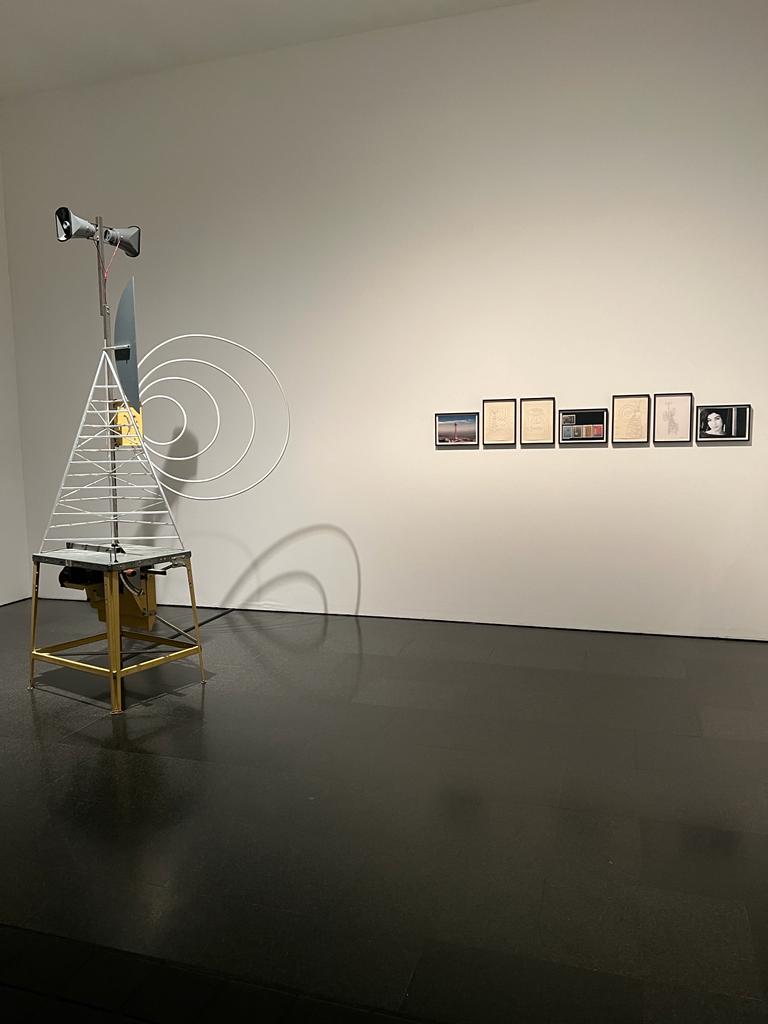
Ângela Ferreira: Talk Tower for Forough Farrokhzad en Colección MACBA. Preludio. Intención poética.
Para más información, pinche aquí
Ângela Ferreira: Talk Tower for Forough Farrokhzad at MACBA Collection: Prelude. Poetic Intention
For more information, click here